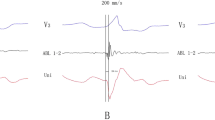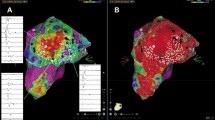Abstract
Purpose
To describe electrocardiographic vector patterns during early VF transition (Wiggers stage 1).
Methods
In 100 electrophysiology studies with VF induction, the first 3 beats of VF were analyzed in lead I for left/right axis (LA/RA), V1 for left/right bundle (LB/RB), and aVF for superior/inferior axis (SA/IA). Correlation with demographic/clinical factors was performed using regression analyses and mixed effect modeling.
Results
VF initiated more likely with LA than RA (P < 0.001) and LB than RB (P = 0.04) suggesting original wavebreak in the right ventricle. The 3-dimensional morphology changed in 69% of VF during the first 3 beats, with predominant increase in RB, suggesting a transition of QRS-originating vector to septum/left ventricle. Conservation of morphology (31%) was favored by initial RB (P = 0.002) and LA morphology (P = 0.01). Initiation of VF with LA vs RA was more likely in African-Americans (P = 0.016) and increasing age (P = 0.032). Ischemic cardiomyopathy favored VF initiation with RB 6.7-fold (P = 0.025), possibly linking LV myocardial scar to initial VF wavebreak location. Male gender and ischemic cardiomyopathy prolonged time-to-loss of predominant vector by 119% (P = 0.002) and 71% (P = 0.017), respectively, suggesting more preserved anatomic/functional reentry.
Conclusion
The predominant QRS vectors during early Wiggers stage 1 VF are not random and suggest an initial wavebreak more commonly in the right ventricle, followed by a transitional shift to the septum/left ventricle. Ethnicity, male gender, age, and co-morbidities result in directional preservation of initiating VF vectors possibly due to myocardial mass/fibrosis. Findings may allow new treatment/ablation approaches.








Similar content being viewed by others
Abbreviations
- BMI:
-
Body mass index
- CI:
-
Confidence interval
- IA:
-
Inferior axis
- IR:
-
Incidence rate
- LA:
-
Left axis
- LB:
-
Left bundle
- LV:
-
Left ventricle
- EF:
-
Ejection fraction
- NPV:
-
Negative predictive value
- OR:
-
Odds ratio
- OT:
-
Outflow tract
- PPV:
-
Positive predictive value
- PVC:
-
Premature ventricular complex
- RA:
-
Right axis
- RB:
-
Right bundle
- RV:
-
Right ventricle
- SA:
-
Superior axis
- CZ:
-
Conversion zone
- VF:
-
Ventricular fibrillation
References
Anderson RD, Kumar S, Kalman JM, Sanders P, Sacher F, Hocini M, et al. Catheter ablation of ventricular fibrillation. Heart Lung Circ. 2019;28(1):110–22. https://doi.org/10.1016/j.hlc.2018.09.005.
Krummen DE, Ho G, Villongco CT, Hayase J, Schricker AA. Ventricular fibrillation: triggers, mechanisms and therapies. Futur Cardiol. 2016;12(3):373–90. https://doi.org/10.2217/fca-2016-0001.
Aras KK, Kay MW, Efimov IR. Ventricular fibrillation: rotors or foci? Both! Circ Arrhythm Electrophysiol. 2017;10(12). https://doi.org/10.1161/CIRCEP.117.006011.
Multicenter automatic defibrillator implantation trial (MADIT): design and clinical protocol. MADIT Executive Committee. Pacing Clin Electrophysiol. 1991;14(5 Pt 2):920–7.
Chen PS, Wolf PD, Dixon EG, Danieley ND, Frazier DW, Smith WM, et al. Mechanism of ventricular vulnerability to single premature stimuli in open-chest dogs. Circ Res. 1988;62(6):1191–209. https://doi.org/10.1161/01.res.62.6.1191.
Lee JJ, Kamjoo K, Hough D, Hwang C, Fan W, Fishbein MC, et al. Reentrant wave fronts in Wiggers’ stage II ventricular fibrillation. Characteristics and mechanisms of termination and spontaneous regeneration. Circ Res. 1996;78(4):660–75. https://doi.org/10.1161/01.res.78.4.660.
Bourgeois EB, Reeves HD, Walcott GP, Rogers JM. Panoramic optical mapping shows wavebreak at a consistent anatomical site at the onset of ventricular fibrillation. Cardiovasc Res. 2012;93(2):272–9. https://doi.org/10.1093/cvr/cvr327.
Noszczyk-Nowak A, Cepiel A, Janiszewski A, Paslawski R, Gajek J, Paslawska U, et al. Normal values for heart electrophysiology parameters of healthy swine determined on electrophysiology study. Adv Clin Exp Med. 2016;25(6):1249–54. https://doi.org/10.17219/acem/65808.
Cheniti G, Vlachos K, Meo M, Puyo S, Thompson N, Denis A, et al. Mapping and ablation of idiopathic ventricular fibrillation. Front Cardiovasc Med. 2018;5:123. https://doi.org/10.3389/fcvm.2018.00123.
Cheniti G, Hocini M, Martin R, Sacher F, Dubois R, Haissaguerre M, et al. Is VF an ablatable rhythm? Curr Treat Options Cardiovasc Med. 2017;19(2):14. https://doi.org/10.1007/s11936-017-0511-0.
Haissaguerre M, Hocini M, Cheniti G, Duchateau J, Sacher F, Puyo S, et al. Localized structural alterations underlying a subset of unexplained sudden cardiac death. Circ Arrhythm Electrophysiol. 2018;11(7):e006120. https://doi.org/10.1161/CIRCEP.117.006120.
Shirakabe A, Ikeda Y, Sciarretta S, Zablocki DK, Sadoshima J. Aging and autophagy in the heart. Circ Res. 2016;118(10):1563–76. https://doi.org/10.1161/CIRCRESAHA.116.307474.
Meschiari CA, Ero OK, Pan H, Finkel T, Lindsey ML. The impact of aging on cardiac extracellular matrix. Geroscience. 2017;39(1):7–18. https://doi.org/10.1007/s11357-017-9959-9.
Biernacka A, Frangogiannis NG. Aging and cardiac fibrosis. Aging Dis. 2011;2(2):158–73.
Shimizu I, Minamino T. Physiological and pathological cardiac hypertrophy. J Mol Cell Cardiol. 2016;97:245–62. https://doi.org/10.1016/j.yjmcc.2016.06.001.
Wong TC, Piehler KM, Kang IA, Kadakkal A, Kellman P, Schwartzman DS, et al. Myocardial extracellular volume fraction quantified by cardiovascular magnetic resonance is increased in diabetes and associated with mortality and incident heart failure admission. Eur Heart J. 2014;35(10):657–64. https://doi.org/10.1093/eurheartj/eht193.
Jia G, Hill MA, Sowers JR. Diabetic cardiomyopathy: an update of mechanisms contributing to this clinical entity. Circ Res. 2018;122(4):624–38. https://doi.org/10.1161/CIRCRESAHA.117.311586.
Russo I, Frangogiannis NG. Diabetes-associated cardiac fibrosis: cellular effectors, molecular mechanisms and therapeutic opportunities. J Mol Cell Cardiol. 2016;90:84–93. https://doi.org/10.1016/j.yjmcc.2015.12.011.
Yue Y, Meng K, Pu Y, Zhang X. Transforming growth factor beta (TGF-beta) mediates cardiac fibrosis and induces diabetic cardiomyopathy. Diabetes Res Clin Pract. 2017;133:124–30. https://doi.org/10.1016/j.diabres.2017.08.018.
Nunoda S, Genda A, Sugihara N, Nakayama A, Mizuno S, Takeda R. Quantitative approach to the histopathology of the biopsied right ventricular myocardium in patients with diabetes mellitus. Heart Vessel. 1985;1(1):43–7.
Kamimura D, Suzuki T, Furniss AL, Griswold ME, Kullo IJ, Lindsey ML, et al. Elevated serum osteoprotegerin is associated with increased left ventricular mass index and myocardial stiffness. J Cardiovasc Med (Hagerstown). 2017;18(12):954–61. https://doi.org/10.2459/JCM.0000000000000549.
Jansen van Vuren E, Malan L, Cockeran M, Scheepers JD, Oosthuizen W, Malan NT. Fibrosis and coronary perfusion - a cardiovascular disease risk in an African male cohort: the SABPA study. Clin Exp Hypertens. 2016;38(5):482–8. https://doi.org/10.3109/10641963.2016.1151524.
Zhao D, Post WS, Blasco-Colmenares E, Cheng A, Zhang Y, Deo R, et al. Racial differences in sudden cardiac death. Circulation. 2019;139(14):1688–97. https://doi.org/10.1161/CIRCULATIONAHA.118.036553.
Buxton AE. Programmed ventricular stimulation: not dead. Circulation. 2014;129(8):831–3. https://doi.org/10.1161/CIRCULATIONAHA.113.007747.
Funding
This research did not receive any specific grant from funding agencies in the public, commercial, or not-for-profit sectors.
Author information
Authors and Affiliations
Corresponding author
Ethics declarations
Conflict of interest
MM, KC, ST, JM, RV, AA, AJR, VS, and SS declare no relationship with industry. TD declares a General Electric grant and consulting for Biosense, Philips, Abbott, and Impulse dynamics.
All authors declare no conflict of interest related to this work.
Additional information
Publisher’s note
Springer Nature remains neutral with regard to jurisdictional claims in published maps and institutional affiliations.
Rights and permissions
About this article
Cite this article
Meddeb, M., Chaudhry, K., Timilsina, S. et al. Dominant vector changes during early wavebreak/spiral wave (Wiggers stage 1) in ventricular fibrillation: insights from the analysis of 100 electrophysiology studies. J Interv Card Electrophysiol 63, 153–164 (2022). https://doi.org/10.1007/s10840-021-00945-9
Received:
Accepted:
Published:
Issue Date:
DOI: https://doi.org/10.1007/s10840-021-00945-9




